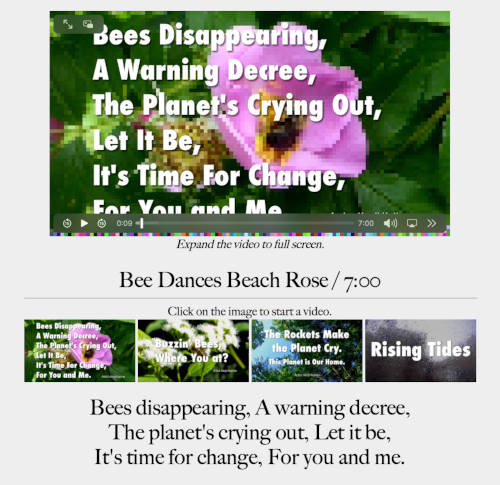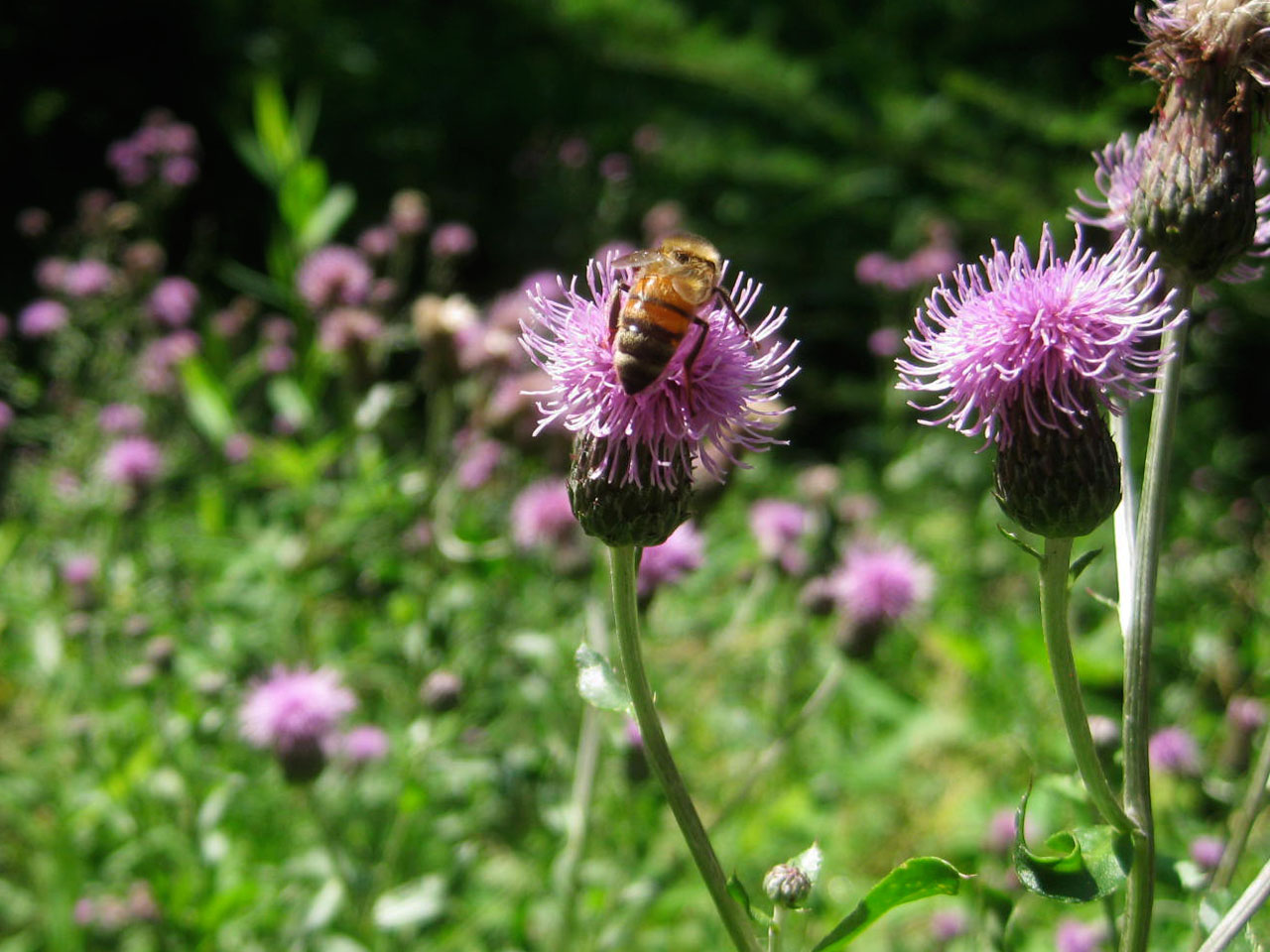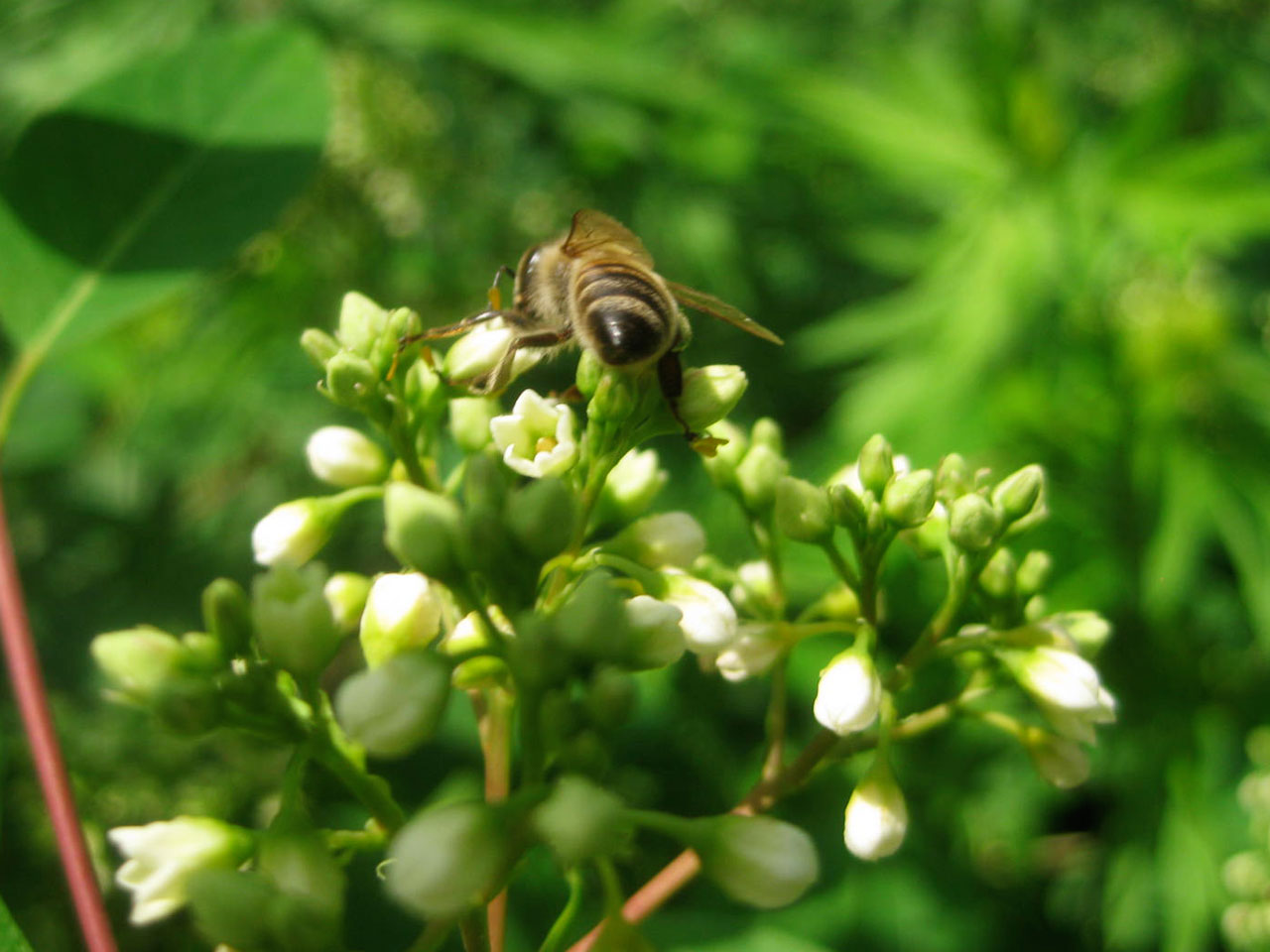Click on the image to select a video.
1.
 2.
2. 3.
3. 4.
4.
1. Anthropocene, Spaceship Earth, Bee, Beach Rose-1 / 5:00/ 2023
2. Anthropocene, Spaceship Earth, Bees, Beach Roses-2 / 4:20 / 2023
3. Anthropocene, Spaceship Earth, Bee, Boneset Flower / 10:00 / 2023
4. Free to Share - Anthropocene / 02:40 / 2023
2. Anthropocene, Spaceship Earth, Bees, Beach Roses-2 / 4:20 / 2023
3. Anthropocene, Spaceship Earth, Bee, Boneset Flower / 10:00 / 2023
4. Free to Share - Anthropocene / 02:40 / 2023
The Ecosystem around Spaceship Earth
is still barely functioning in a state of crisis.
The colors are transformed into music by the algorithm.
The artwork "Anthropocene, Spaceship Earth, Bees, Boneset Flower" is
part of the "Anthropocene Project" at The New Museum of Networked Art.
|
This site's videos are free to share. You can donate any amount to the artist if you approve of the video as art. Even if you disapprove, you can keep it. But it has no artistic value, as you have determined. Download: 1920x1080 Anthropocene, Spaceship Earth, Bee, Beach Rose-1, 234.6 MB Anthropocene, Spaceship Earth, Bees, Beach Rose-2, 189.5 MB Anthropocene, Spaceship Earth, Bees, Boneset Flower, 454.5 MB  Series "The Ecosystem around Spaceship Earth" is licensed under
Series "The Ecosystem around Spaceship Earth" is licensed underCreative Commons Attribution 4.0 International License. Credit must be given to the creator. 日本からのドネーションはここをクリック。 日本から任意の金額のドネーションはできません。 Show: Japanese / 日本語
Hide: Japanese / 日本語
Anthropocene, Spaceship Earth, Bee 人新世、宇宙船地球号、蜂 このプロジェクトは、3つの主要テーマに焦点を当てています。第一に、世界を認識する上での、人間とデジタルの感覚の相互作用を探求しています。このアートはミツバチの活動を通して、視覚と聴覚の関係を探っています。アルゴリズムは、ミツバチの画像のバイナリ・カラーデータから音符を抽出し演奏します。 第二に、宇宙船地球号を取り巻く生態系は、危機的状況に瀕しています。生態系の脅威は、人間、ミツバチ、その他の種を危険にさらしています。その影響は生態系全体に波及し、生命を維持する微妙なバランスを崩しています。私たちは生態系崩壊の危機に瀕しており、地球との関係を見直す必要性があります。 第三に、人新世のほとんどは貨幣経済における、際限のない物質的欲望の蓄積です。 私たちは生き方を再構築する必要に直面しています。 デジタルアートの最大の特徴は、本物のアートを無限にコピーできることです。 それは金銭崇拝の貪欲な物質の所有欲を破壊し、アートの異常な金融商品的な価値を回復させて、個々の鑑賞者とのつながりを復活させます。 このビデオは CC ライセンスの下で無料で配布されています。 Hide: Japanese / 日本語 This project focuses on three main themes. First, the ecosystem of Spaceship Earth is precarious and in crisis. The ecological threat endangers humans, bees, and other species. The consequences reverberate through ecosystems, disrupting the delicate balance that sustains life. We are on the brink of ecological collapse, underscoring the need to reevaluate our relationship with the earth. Second, the artist explores the interplay between human and digital senses in perceiving the world. The art explores the relationship between seeing and hearing through the activity of bees, using an algorithm to extract and play musical notes from binary color data in bee images. Third, this video is free under its CC license. The Anthropocene is an accumulation of endless material desires in a monetary economy. The greatest feature of digital art is that real art can be infinitely copied. It abandons the greedy material possessions of the worship of money, restores the abnormal financial commodity value of art, and revives its connection to the individual viewer. Modern civilization has pursued material wealth for a better life. However, it is now widely recognized that the production of materials beyond what is necessary for human subsistence threatens the survival of living beings. It is imperative to prioritize the survival of living beings over the pursuit of material wealth. To address this issue, we must reexamine the diversity of values and lifestyles around the world and redefine the concept of wealth. Acquiring more things does not necessarily lead to future happiness or fulfillment. We must live together on this planet. The Anthropocene is the accumulation of boundless material desire. Infinitely copied digital art without substance destroys the greedy material possessions of money worship and the financial commodity value of art and revives its connection to the individual viewer. It tries to eliminate the abnormal financial situation of art embedded in capitalism and give it a different meaning. If art had meaning even after its monetary value disappeared, it would revive the connection with the viewer. Artist Kenji Kojima believed that seeing and hearing overlapped with information from each of the senses. He developed the experimental art application to see if computer algorithms could reproduce human sensibility. All media in human history are now recorded in digital data as binary (0,1). Binary is the lowest level of machine code that a computer can execute. Binary art material creates the possibility of cross-media sensibility. A recent study at the University of California found that our brains create a stable perception of the environment by assembling disjointed, changing visual information on a timeline. The algorithm he programmed randomly collected disjointed grid data of colors on a timeline in binary, converted them to musical notes, and played midi piano. Also, the data was read in different languages. Technical Reference "Binary as Art Material" by Kenji Kojima Show: Kenji Kojima's Biography
Hide: Kenji Kojima's Biography
Kenji Kojima is a digital artist. Since the early 1990s, he has been experimenting with the relationships between perception and cognition, technology, music, and visual art. He was born in Japan and moved to New York in 1980. He spent his first 10 years in New York City painting with egg tempera. The personal computer improved rapidly in the 1980s. He felt more comfortable with computer art than painting. He converted his artwork to digital in the early 1990s. He developed the computer software for his artwork. But there was a big problem, the software soon did not work on the operating system. He converted his artwork to video while it was working. His ecology-based software and video art were exhibited in New York and at media art festivals around the world. After Covid-19, he could not go out to make a video. In 2021 he started a new series called "The Musical Interpretation of Paintings". At the end of 2023, he returned to his art theme of ecology. LiveCode programmer. Kenji Kojima Resume Digital Art Exhibitions: the USA: 2026-2025 The Wrong Biennale, Online & Offline / 2024 OtoZono at HEART, New York. / 2024 the New Media Art Space at Baruch College, New York. / 2024 All Street, New York / 2023, 2020 Torrance Art Museum, Los Angeles, USA. / 2023 THE ELASTIC MIND, BROWARD College, Weston, Florida. / 2023 SOJOURNER, New York, NY. / 2022 Asian American International Film Festival, New York, NY. / 2012, 2016 Light Year, Brooklyn, New York. / 2021 UNCG International Sustainability Shorts Film Competition, UNC Greensboro, NC, USA. / 2019 The Harold B. Lemmerman Gallery, New jersey City University, Jersey City, NJ. / 2019, 2016, 2015 Williamsburg Art & Historical Center, New York, NY. / 2018 The Exchange, Bloomsburg, PA. 2018 WhiteBox, New York, NY. / 2015 ACM SIGGRAPH Digital Arts Community. / 2014 MediaNoche, New York, NY. / 2008 AC Institute, New York, NY. Europe: 2025 Internationales Digitalkunst Festival 2025, Stuttgart, Germany / 2025 ON SCREEN 2025, Vienna, Austria / 2025 OPEN NIGHTS FESTIVAL Vol.10, Thessaly and Lárisa, Greece / 2025 Selected in the TAA (The Art Association) TAA Open Call Video Competition 2025 Final Candidates (2024 YouTube Exhibition), Geneva, Swiss / 2024 Profusion of Colors, A.E. Corner, Galleria di Tirano, Viale Italia / 2024 Summer of Anthropocene, The New Museum of Networked Art, Cologne, Germany / 2024 DIGITAL VIDEO ART INTERNATIONAL STREAMING FESTIVAL 'The films of the Official Selection 2024', Season 3 & 5, Vienna, Austria / 2024 Technocene Berlin Templehof, Germany. / 2024 Open Media Art, Košice, Slovakia / 2025, 2024, 2023, 2022, 2020, 2019 Ie Rencontres Internationales Traverse, Toulouse, France. / 2021 FEX comtemporary media art, Cologne, Germany. / 2020 Institut für Alles Mögliche, Stützpunkt Teufelsberg, Belrin, Germany. / 2019 The festival BINNAR, Vila Nova de Famalicão, Portugal. / 2019 MADATAC X New Media Arts Festival, Madrid, Spain. / 2018 Athens Digital Arts Festival, Athen, Greece. / 2018 Mitte Media Festival, Berlin, Germany. / 2017 Simultan Festival, Timisoara, Romania. / 2016 Simultan Festival, Timisoara, Romania. / 2016 Brave New World Beyond the Wall, Berlin, Germany. / 2015, 2013 ESPACIO ENTER, Tenerife, Canary Islands, Spain. / 2014 BRAVE NEW WORLD, Berlin, Germany. / 2011 Jyväskylä Art Museum, Jyväskylä, Finland. / 2010 PROCESS Festival, Berlin, Germany. / 2009 RE-NEW Digital Art Festival, Copenhagen, Denmark. / 2002 Free Manifest, Frankfurt am Main, Germany. Brazil: 2025, 2023, 2022, 2020, 2016, 2012, 2011, 2010 FILE (Electronic Language International Festival) São Paulo, Brazil. / 2012 FILE RIO, Rio de Janeiro, Brazil. / 2010 FAD (Festival de Arte Digital), Belo Horizonte, Brazil. the Middle East: 2026 The Ras Al Khaimah Art Festival Biennale, United Arab Emirates / 2020, 2012 Istanbul Contemporary Art Museum, Turkey. / 2020, 2019 Paadmaan Video Event, Isfahan, Iran. Asia: 2021 Thailand New Music and Arts Symposium, Bangkok, Thailand. / 2020 the 150th Anniversary Gandhi Event, Kolkata, India. / 2019 Capital Normal University College of Cape Cod, Beijing, China & China University of Mining and Technology Yinchuan College, Yinchuan, China. / 2018 Gunung Sunda Festival, Sukabumi, West Java, Indonesia. / 2016 CeC 2016, North-Eastern Hill University, Shillong, Meghalaya, India. / 2010 Contemporary International New Media Art Invitational, Wuhan University of Technology, China. Hide: Kenji Kojima's Biography Other Ecological Projects by Kenji Kojima |

This Planet is Our Home.
24 Languages
Participation in "Open Media Art"
in a public space in Košice, Slovakia. May, 2024

Bee Dances / Buzzin' Bees
Climate Messages from Rap, Aria and Reggae



"420 Bee Photos Slideshow" 2011 -
Participation in the "Anthropocene Project" in The New Museum of Networked Art.
https://kenjikojima.com/
Email: index@kenjikojima.com